“Conservation is a state of harmony between men and land.” – Aldo Leopold
Our goal is to preserve, create and enhance the region’s habitats by incorporating conservation best practices and stewardship. Major initiatives include:
- Relevant Habitat Conservation: By defining our habitats or ecosystems of interests, including prairie, forests and wetlands, HPB can effectively assess our Greenway resources for targeted habitats and develop respective long-term maintenance and/or restoration goals. Our conservation projects, like tree plantings, prairie rebuilds or wetland creations, will be directly derived from our assessment, and in turn, allow HPB to engage volunteers in appropriate and relevant projects.
- Engaging Stewardship: Employing our overall mission of “Parks for everyone”, the Conservation program will provide an alternative means to directly connect everyone to parks—by planting native trees, growing prairie seedlings, caring for nursery plants, or invasive species control. Their committed stewardship of the Greenway resources ties their efforts to a deepened sense of ownership and willingness to protect and preserve.
- Effective Communication: As with any effort worth undertaking, the story or messaging communicated about said effort is equally critical. The Conservation program accomplishes large goals of preserving, restoring, and maintaining important natural resources. Sharing the stories of our successes and achievements—whether building bat boxes or rebuilding prairies—helps everyone to know our parks and our greenways.
- Dynamic Partnerships: The Conservation program, like HPB itself, believes in the ongoing collaboration with partners; and this collaboration as the means to achieve larger regional goals—like the exchange of practical measures for prairie ecosystem maintenance.
Interested in staying involved with what’s going on?
Best Management Practices (BMPs)
Our habitat BMPs are designed to establish a standard and provide a consistent approach for our staff and other groups who may wish to use and adopt them. This document serves as a land management guide, offering an initial toolbox for restoration efforts. The BMPs are broad recommendations and should be viewed as the starting point for restoration projects. As a living document, this BMP will be updated over time as the Houston Parks Board gains insights through ongoing implementation and management.
Find each BMP here:
WETLANDS
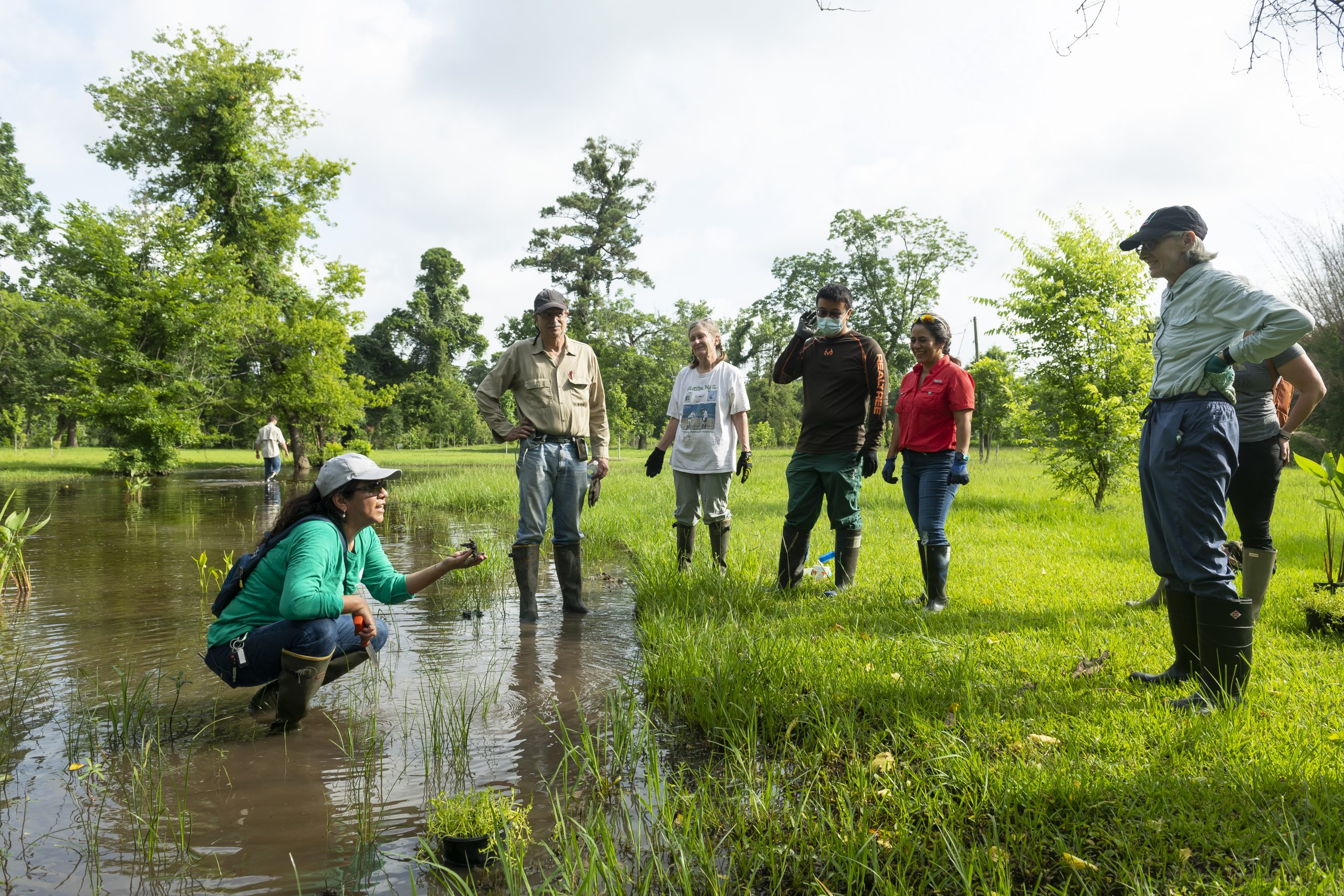
A WETLAND IS A DISTINCT ECOSYSTEM THAT IS FLOODED BY WATER, EITHER PERMANENTLY OR SEASONALLY, THAT CAN SUPPORT BOTH AQUATIC AND TERRESTRIAL SPECIES. WETLANDS, ALONG WITH FORESTS AND PRAIRIES ARE AMONG THE MOST THREATENED ECOSYSTEMS IN HOUSTON AND THROUGHOUT TEXAS. THESE SYSTEMS ARE CONSIDERED AMONG THE MOST DIVERSE SYSTEMS IN THE WORLD. BY RESTORING THESE HABITATS, HOUSTON PARKS BOARD IS PROVIDING A HAVEN FOR WILDLIFE AND HELPING OUR REGION MOVE TOWARDS A MORE PEACEFUL COEXISTENCE WITH NATURE IN AN URBAN SETTING.
The primary factor that distinguishes wetlands from landforms or water bodies is the characteristic vegetation of aquatic plants, adapted to the unique soils. The water that covers the soil in a wetland is present either at or near the surface of the soil, and the hydrology largely determines how the soil develops and the types of plant and animal communities living in and on the soil. The prolonged presence of water creates conditions that favor the growth of specially adapted plants and promote the development of characteristic wetland soils.
NATIONAL ESTUARIES PROGRAM WATERSHED GRANT
Houston Parks Board awarded National Estuaries Program Watershed Grant to restore wetlands and wet meadows along the Bayou Greenways system
In 2024, Houston Parks Board received a National Estuary Program Watersheds grant to restore 8 sites along the Bayou Greenways over the course of 4 years.
Restore America’s Estuaries, in close coordination with and financial support from the U.S. Environmental Protection Agency (EPA), administers the National Estuaries Program (NEP) Watersheds Grants. The Program is a nationally competitive grants program designed to support projects that address urgent, emerging, and challenging issues threatening the well-being of estuaries within the 28 NEP boundary areas.
Community Engagement for the NEP
As part of the grant, surrounding communities should be engaged to learn about and help create wetlands. Houston Parks Board is leading community engagement and will host a webinar and wetland event for most of the sites, but some webinars might be combined as well as volunteer events where possible/where the wetland sites are close in proximity. Please see below engagement opportunities for more information.
Overall Goals
- Reinforce the purpose of wetlands to the public
- Emphasize the importance of this critical work to the future of our waterways
- Provide opportunities for public interaction through webinars and volunteer events
- Highlight and uplift additional grant partners, including American Youthworks, Student Conservation Association, Native’s Nursery, and Greenstar Wetland Plant Farm
Engagement Opportunities
- Sims Bayou Wetland Site at River Drive Trailhead
- Sept. 24, 2024 Sims Bayou Wetland Webinar
- HPB hosted a webinar on Zoom specifically about the wetland being created in the Park Place Neighborhood at the Sims Bayou River Drive Trailhead site. Over 70 people joined. To view the presentation and recording, click here: https://drive.google.com/drive/folders/1fpSknoBTKjL6zFEmUm2FyyPIex2Kd8Kq?usp=sharing
- Oct. 26, 2024, Sims Bayou Wetland Volunteer Event
- HPB hosted a follow-up wetland volunteer event at the River Drive Trailhead on
Saturday, Oct. 26, from 9 AM to 12 PM. Volunteers planted over 380 forbs,
contributing to the creation of the new wetland.
- HPB hosted a follow-up wetland volunteer event at the River Drive Trailhead on
- Sept. 24, 2024 Sims Bayou Wetland Webinar
- Sims Bayou Wetland Site at Erie Stree
- April 10, 2025, Sims Bayou Wetland Webinar
- HPB hosted a webinar on Zoom about the wetland being created along Sims Bayou at the end of Erie Street. To view the presentation and recording, click here: https://drive.google.com/drive/folders/1p3DUD_J8dDYIyKjg5ZG2vc7PGjBDu1nm?usp=sharing
- May 3, 2025, Sims Bayou Wetland Volunteer Event
- On May 3 from 9 AM 10 12 PM, Houston Parks Board will host a follow-up wetland volunteer event at the end of Erie Street along Sims Bayou. To RSVP for the event and learn details on where to park, click here: https://houstonparksboard.volunteerhub.com/vv2/event/53c78b10-5122-49f6-b39a-88e346ade7bb
- April 10, 2025, Sims Bayou Wetland Webinar
Questions? Email info@houstonparksboard.org or call 713-942-8500 for more information.
THE PRAIRIE, FORMERLY KNOWN AS MEADOW
Our original planning for the greening of the Bayou Greenways included the establishment of meadow areas adjacent to the trail system anywhere possible. The intention is to reduce maintenance and pollution outputs, create habitat and greener greenspaces and diversify the “look” of the trails.
Any reconstruction or restoration must start at the very beginning and typically this includes a detailed survey or assessment of the project site current conditions. For our new prairies, this assessment entails the on-going evaluation by our Conservation team across multiple seasons and across all our Bayou Greenways covering 150+ linear miles weaving through our City.

Before picture of Watonga site.
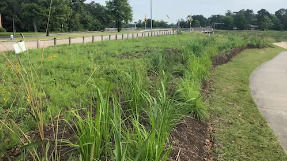
After picture of Watonga site. Within a few months after installing new prairie plants, the seeds of native grasses and forbs have sprouted.
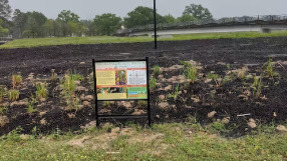
After a recent volunteer workday installing new native plants, educational signage is installed.
BAT HOUSES ALONG THE BAYOU GREENWAYS
Why do we need bats?
Bats comprise the second largest order (20%) of mammals worldwide, and their feeding habits, as major insectivores, helps to control pest populations wherever a healthy bat population exists. This ecosystem service represents one benefit of many which endeared bats and their colonies to their human neighbors.
More recently, watching bats emerge from their roosts en masse has become a popular evening pastime in cities or locations near large bat colonies. The Watonga Boulevard Bridge population is one such location and is located on our White Oak Bayou Greenway.
HPB is fortunate to have the support of local experts, including having a board member who is respected within the Bat community, who can provide the necessary guidance with regards to our Greenway bats.
Existing bat boxes are regularly visited and examined to determine their use and placement. It was determined that the boxes, in general, did not meet the guidelines of Bat Conservation International which require larger boxes set on higher extensions (greater than 12 feet high).
HPB makes an effort to replace inadequate existing boxes with better, more inviting homes. Placing darkly-painted back to back boxes on 20 foot extensions with roof coverings offers potential refuge for younger male bats from the larger colony.
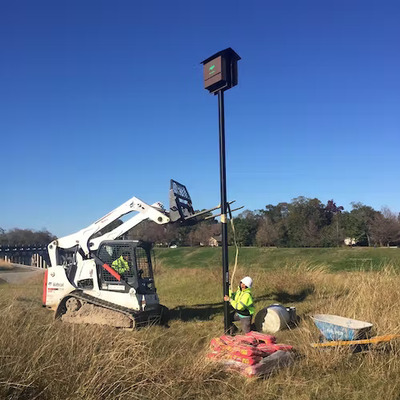
Providing bat houses, which mimic the space between bark and a tree trunk—dark, warm and narrow—can be essential in areas where trees are sparse or unavailable; or as an alternative when flood events occur and force the vacating of bridge roosts. Building and placing these new homes on the Greenways is our attempt to sustain our local bat populations.
JOIN THE GREEN TEAM
Our conservation effort can not be complete without the input of our surrounding community. Engaging our citizens in the direct care of the Greenways and their associated habitats fosters a strong sense of stewardship.
To further this goal, HPB has an active “Green Team”, a volunteer group which meets one a month (for now!) to complete conservation tasks at various locations around the Bayou Greenways. We could be at Thomas Bell Foster Park on Lower Greens Bayou Greenway planting wetland plants, or at Coolgreen Corridor removing invasive shrub vegetation or at Sims Bayou Greenway rescuing our native forbs and grasses in preparation for a prairie rebuild. Our workdays are a chance for these conservation-minded volunteers to come together to sweat over the necessary work, share time and laughter, and enjoy a meal together.
And HPB has plans to grow into the future! We hope to establish our own small-scale nursery to grow some of our common restoration plants, but also have the capacity to hold classes and lectures for our volunteers.
Houston Parks Board currently holds the Green Team workdays on the second Wednesday of the month from 9am to 12noon. We ask volunteers to bring a lunch for the downtime after the workday. We provide tools, supplies and drinking water.
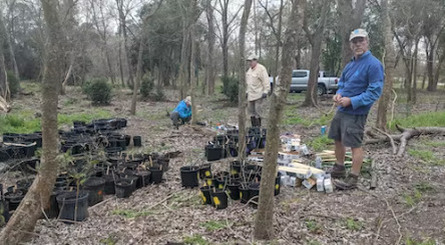
Green Team members marking and preparing tree seedlings for Coolgreen Corridor as part of ParksByYou Day.
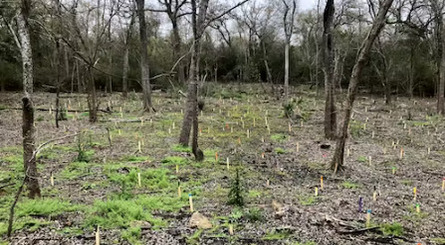
After marking and preparing tree seedlings for Coolgreen Corridor as part of #ParksByYou Day.
If you’re interested in getting involved with any of our conservation efforts or have questions, reach out to volunteer@houstonparksboard.org
